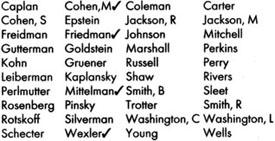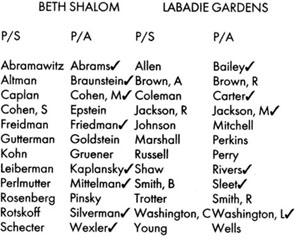Due Diligence (22 page)
Authors: Michael A Kahn

“When did this happen?”
“In the summer. I know that, honey, because it was so hot.”
“Which summer?”
She scratched her chin as she mumbled under her breath, trying to place it in relation to other events. “Arthur was born that yearâ¦no, that was the year beforeâ¦we had that picnic over at the Alton Locksâ¦no, that was the next summer⦔ Finally, she looked up with a helpless shrug. “It was either the summer of 1973 or the summer of 1974. I can't be sure which year, but it was one of those two for sure.”
I referred back to the list. “And you think Mrs. Wexler was one of the people who died that weekend?”
She nodded sadly.
“Any others on the list?”
She looked down the list again, shaking her head. “My memory just isn't what it should be, honey. Maybe Mrs. Gutterman. Maybe Mrs. Silverman. I just can't be sure.”
I thanked Matilda Jackson for her help and walked back to the front of the building. From a pay phone in the lobby I called for a County Cab.
“Destination?” the dispatcher asked.
“The St. Louis County Library on Lindbergh,” I said.
Matilda's memory would serve as my compass to navigate through the official records.
With the
Post-Dispatch
indexes for 1973 and 1974 on the table to my right and the rack of microfilm to my left, I looked down at my photocopy of the Beth Shalom/Labadie Gardens lists. I started alphabetically with the A's. The first “A” was Abramawitz.
Matilda vaguely recalled summer as the time of year. Specifically, she recalled hot and humid. In St. Louis, that narrowed it to May through September. I checked the obituaries for that period during 1973. None for Abramawitz. I checked the obituaries for 1974. None again.
The next “A” was Abrams. I checked the obituaries for May through September of 1973. There were two Abramsâone on May 8 and one on July 3. I jotted down the dates. I checked the obituaries for 1974. There was one Abrams: August 26. I wrote the date on my pad.
I reached over and sorted through the microfilm rack. I found the reels for the first half of May 1973, the first half of July 1973 and the second half of August 1974. Starting with May 1973, I threaded the microfilm and advanced the reel to the front page of the May 8 issue of the
Post-Dispatch
, pausing to check the weather forecast: a high of 82° with a chance of afternoon showers.
Possible
.
I advanced the reel to the obituaries and funeral notices. I found my first Abrams under the funeral notices:
ABRAMS, TYRONE R., Blessed with the Sacraments of Holy Mother Church, May 2, 1974, 89 years, beloved husband of the late Gertrude, loving father of Thomas and Catherine, grandfather, brother-in-law, father-in-law, uncle, relative and special friend.
Funeral Tues., 9:30 a.m. from HOFFMEISTER COLONIAL Mortuary, 6464 Chippewa at Watson, Visitation Tues., 9:15 a.m. with Mass celebrated at the Church of Annunciation, 10 a.m., Internment Resurrection Cemetery.
Whatever else he had been during his nine decades, Tyrone Abrams clearly had never been a resident of Beth Shalom.
Nor had the second Abrams, whose obituary appeared in the July 3, 1973, issue of the
Post-Dispatch
. Randall Abrams, age 20, had died in an automobile crash on Highway 70 while home for summer vacation from Drake University.
The third Abrams obit was Monday, August 26, 1974. The front page of that day's
Post-Dispatch
had an appropriate weather forecast: hot and humid, with a high of 101°. I advanced the reel to page 4 of Section B and found the funeral notice:
ABRAMS, RUTH S., August 23, 1974, beloved wife of the late Milton, dear mother of Karen and Lee, beloved grandmother of Cory, Kelly, Lara, and Kyle, dear sister of Jack (Rose) Sanders and the late Ida Turner.
Funeral service Tues., 2 p.m., at RINDSKOPF-ROTH Funeral Chapel, 5216 Delmar Blvd. VISITATION 1:30 p.m. Burial at Chesed Shel Emeth Cemetery. Contributions preferred to Beth Shalom or a charity of your choice.
Bingo
.
I studied the funeral notice. Ruth Abrams had died on August 23. Her notice was in the August 26 edition of the
Post-Dispatch
. I glanced up to the top of the page. Monday, August 26, 1974. So Ruth had died on the prior Friday. Was she one of the three who had died that Friday? I skimmed through the rest of the funeral notices. Sure enough, I found the other two: Thelma Friedman and Anna Mittleman. I also found Lenore Wexler, who had died on Saturday, and Margaret Cohen, who had died on Sunday.
Ruth, Thelma, Anna, Lenore, and Margaret. Five elderly women, who spent their last weekend together, covered with sheets and propped silently on the chairs as the Beth Shalom barber shop air conditioners rumbled.
I glanced down the Beth Shalom/Labadie Gardens list and placed check marks by their names:


I leaned back in my chair and stared blankly at the screen of the microfilm reader. There were four obituaries grouped above the funeral notices. One of the headlines caught my eye:
LUCILLE WASHINGTON;
LONGTIME TEACHER
I glanced at the list. Sure enough, there was a “Washington, L” in one of the Labadie Gardens columns. I read the first paragraph of the obituary:
Lucille (Henson) Washington, a former teacher and reading specialist in the St. Louis Public Schools system, died Sunday (Aug. 25, 1994) at the Labadie Gardens Nursing Home after a brief illness. She was 76.
I carefully reviewed the rest of the funeral notices on the pages, looking for any other matches with the names on the two Labadie Gardens columns. There were none.
I read through the Lucille Washington obituary again. It seemed an unusual coincidenceâa name from one of the Labadie Gardens columns just happened to show up on the same page of funeral notices as a name from a Beth Shalom column. Slowly and methodically, I advanced the reel forward to the obituaries and funeral notices for each successive day in August and then for each day in September. The “coincidences” continued.
Each time I found a match, I photocopied the page and checked off the name on the Beth Shalom/Labadie Gardens list. I located a total of fifteen, all of whom had died between August 23 and September 4, 1974. The pattern looked strange. To double-check the results, I expanded my search to include the entire year of 1974. To my surprise, the expanded search did not add a single name from the Beth Shalom/Labadie Gardens list. When I finished, I looked at my results:

I stared at the list, trying to make sense of it. In a period of less than two weeks, fifteen people out of forty-eight on the list had died. At two separate institutions, the only people on the list who died were under the column headed “P/A.” Indeed, if you focused only on the “P/A” columns, fifteen out of a total of twenty-four had diedâeight at Beth Shalom and seven at Labadie Gardens. More than half of the names on each column.
And all fifteen were women.
And all were listed on a document bearing the private watermark of Armstrong Bioproducts.
Obviously, all fifteen womenâeight Jews, seven blacksâhad something in common. Something important. And fatal. Fatal to them and, for different reasons, fatal to at least two men: Bruce Rosenthal and David Marcus.
I gathered my notes and photocopies, stuffed them in my briefcase, and went over to the pay phone. It was quarter after three. I dialed the number of the Jewish Center for the Aged.
“Mark Levine,” I told the receptionist.
“Hi,” he said cheerfully. “How are you?”
“Fine,” I said in a businesslike tone. “What did you find?”
“How about we meet somewhere to talk?”
“How about we start by you telling me over the phone what you found?”
There was a pause. “Okay. Well, there's a problem.”
“What's the problem?” I asked.
“The Beth Shalom records don't go back before 1981.”
“Why not?”
“I'm not sure. It merged into the JCA in November of 1984. Apparently, the older records weren't among the files transferred in the merger.”
“Were they destroyed?” I asked.
“I honestly don't know. We followed the paper trail back to 1981. That's where it ends.”
“Damn,” I said in frustration.
“I thought Matilda might know the answer,” he said, “but she doesn't. However, she did say that Mrs. Jacobs might know. In fact, she says that the records might be stored in the basement of the Jacobs' home.”
“Does Mrs. Jacobs still live in St. Louis?”
“Matilda thinks so.”
“Does she know where?”
“No.”
“Do you have her number?”
“I don't, and neither does Matilda. Apparently, it's unlisted.”
“One more question,” I said.
“That's what I'm here for.”
“Do you have physicians on your staff?”
“No. We have a contract with Mt. Sinai Hospital. They provide our doctors.”
“How long has that been the case?”
“For a long time. Nursing homes don't generally have their own physicians. They usually contract with a hospital.”
“Would that be the same hospital where one of your residents would be taken if they needed hospitalization?”
“That's usually how it works.”
I thanked him for his help, declined his invitation to “brainstorm” together over a drink after work, hung up the phone, and stepped back into the main area of the library. I surveyed the crowd, searching for someone who might seem out of place among the retirees leafing through magazines, the mommies on the carpet in the children's section reading books to their children, the earnest young men in business suits hunched over thick books in the reference section. One or two looked up at me curiously, but none appeared sinister.
I went over to the medical reference section. As long as I was in a library, I should try to fill in the gaps in my knowledge of Guillain-Barré syndrome. I found a listing in a medical encyclopedia and photocopied all three pages on the subject.
I checked my watch: almost four o'clock. I might have enough time. There were two cabs at the taxi stand outside. I got into the backseat of the first one. The driver glanced at me in the rearview mirror and then spun around with a leer.
“Ah, hello to you, my dear lady. Again it is that we meet.”
“Oh, no,” I groaned. It was the same swarthy man with the thick black mustache and all-consonant names. I yanked open the door. “Forget it, creep,” I said, slamming the door closed behind me.
“But lovely lady,” he called after me.
I walked back to the second cab, opened the front passenger door, and leaned in. The driver was an old black man reading the newspaper.
“Do you know where the Bureau of Vital Statistics is?” I asked.
He neatly folded his newspaper. “Would that be county or city, ma'am?”
“City.”
He nodded. “I certainly do. Hop in.” I got in back and he pulled away from the curb, swinging wide of the first cabbie, who was now standing outside his cab and shouting at me in some guttural language.
